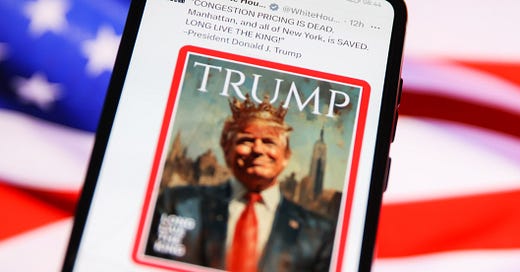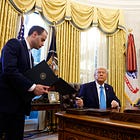How Trump's lawyers are trying to make him a king
They're advancing a roided-up version of the "unitary executive theory."
⚔️ 🫅 🏰 With corporate outlets obeying in advance, supporting independent political media is more important right now than ever. Public Notice is possible thanks to paid subscribers. If you aren’t one already, please click the button below and become one to support our work. 🏰 🫅 ⚔️
There’s a viciously haphazard feel to these opening weeks of Donald Trump’s second term.
Elon Musk seems to have complete authority to slash and burn as he sees fit. Government agencies are being stripped of their core missions and reconfigured instead to serve as weapons. A staggering number of federal employees have been fired. But the throughline for these actions is the same — an assertion of unfettered presidential authority.
Trump is consolidating power within the White House, and while the scope of his actions is unprecedented, the idea underpinning them is not. It’s the unitary executive theory, albeit on a wild amount of steroids, and it’s already showing up in various administration court filings defending Trump’s illegal power grabs.
The unitary executive theory says that the president has complete authority over the executive branch. It’s been kicking around since the Reagan years but really came of age under George W. Bush. During the war on terror, torture enthusiast and Department of Justice lawyer John Yoo argued that there were “no limits on the executive's judgment” regarding using military force. So, no check, no balance, no limits.
Bill Barr, who served as attorney general in Trump’s first administration, is a longtime fan of the theory. Barr believes it is unconstitutional for Congress to limit the president’s control over executive branch personnel in any way, a radical view that vests all hiring and firing authority in the president only.
To understand why that’s so extreme, we must go back 90 years to a 1935 United States Supreme Court case, Humphrey's Executor v. United States. There, Franklin D. Roosevelt removed William Humphrey from the Federal Trade Commission. Humphrey was a Republican appointee, first appointed by President Calvin Coolidge and reappointed by President Herbert Hoover. Unsurprisingly, he wasn’t aligned with Roosevelt’s goals, so Roosevelt fired him. However, in the law establishing the FTC, Congress limited the ability of the president to remove commissioners to situations of “inefficiency, neglect of duty, or malfeasance in office,” none of which had happened.
A note from Aaron: Working with brilliant contributors like Lisa takes resources. If you aren’t already a paid subscriber, please sign up to support our work.
Congress took further steps to ensure the independence of the FTC commissioners. They are nominated to fixed terms, and no more than three may be members of the same party. This means that each administration will always inherit some commissioners from previous presidents and that the commission will always have bipartisan membership. This is in direct contrast to Cabinet-level agencies, where the president gets to install partisan leadership.
In holding that Roosevelt did not have the right to remove Humphrey, the Supreme Court found that in creating the FTC, Congress had intended to create “a body of experts who shall gain experience by length of service — a body which shall be independent of executive authority except in its selection, and free to exercise its judgment without the leave or hindrance.” To perform its duties, the commission needed to be free from executive control.
The FTC isn’t the only agency arranged like this. There are nearly two dozen independent regulatory agencies, including the National Labor Relations Board (NLRB) and the Consumer Product Safety Commissionm (CPSC). Under the Trump administration’s roided-up version of the unitary executive theory, Humphrey’s Executor was wrongly decided, and restrictions on the ability of the president to remove members of those bodies are unconstitutional.
In fact, that’s exactly what acting Solicitor General Sarah Harris wrote earlier this month to Sen. Dick Durbin, the ranking member of the Judiciary Committee. In a brief one-and-a half-page letter, Harris decreed that the removal protections for the FTC, NLRB, and CPSC, specifically, are unconstitutional. Harris, a former law clerk for Justice Clarence Thomas, also told Durbin that the administration intends to ask the Supreme Court to overrule Humphrey’s Executor.
The letter to Durbin isn’t the only place where the administration is laying out its unitary executive vision. One week after taking office, Trump removed Gwynne Wilcox from the NLRB. Wilcox, a Biden appointee, had been confirmed by the Senate in 2023 for a five-year term. NLRB members, however, can only be removed after notice and hearing, and then only for “neglect of duty or malfeasance in office, but for no other cause.” The late-night email firing Wilcox did not detail any neglect or malfeasance.
Wilcox sued to be reinstated, a move that is dicey. That’s because there’s no question her firing is intended as a test case to get in front of a rightwing Supreme Court that is friendly to Trump’s maximalist vision of presidential power. Indeed, the administration’s brief in the federal district court makes no argument that Wilcox’s firing was permitted under the removal language in the National Labor Relations Act. Instead, it argues that the Supreme Court has already significantly limited Humphrey’s Executor in other cases and that the removal restrictions in the NLRA are an unconstitutional restriction on presidential authority.
While Wilcox’s case is proceeding through the lower courts, a different illegal removal is already up at the Supreme Court. Sort of.
On February 7, Trump removed Hampton Dellinger, the head of the Office of Special Counsel (OSC) appointed by President Biden in 2024. That agency, created by Congress after Watergate, protects federal employees from discrimination and retaliation and provides a secure channel for federal whistleblowers to come forward.
Under the law, the OSC head is appointed to a five-year term and can only be removed for “inefficiency, neglect of duty, or malfeasance in office” — the same language in the FTC statute. But Trump’s removal of Dellinger came via a one-line email that didn’t provide any rationale for the firing. Dellinger sued and was temporarily reinstated to the position for 14 days by a lower court judge, a decision the DC Circuit Court of Appeals declined to overturn while the case proceeds. The administration raced to the Supreme Court, arguing that the two-week temporary restraining order was essentially the death of liberty, raising “grave issues of democratic legitimacy and electoral accountability.”
So, at this stage, all the parties are fighting over is the existence of the TRO. For now, the Supreme Court has punted on the question, leaving the TRO restoring Dellinger in place because it was already set to expire on February 26. But the Supreme Court will eventually have to tackle the underlying question of whether Trump can fire Dellinger without cause despite a statute explicitly saying cause is required, just as it will have to someday tackle whether Wilcox could be removed.
SCOTUS learns to love autocracy
Ultimately, Trump will need at least five of the right-wingers on the United States Supreme Court to agree to his expansive view of presidential power. A few short decades ago, that would have been impossible.
Back in 1988, Justice Antonin Scalia was the sole dissenter in Morrison v. Olson, which upheld a law where Congress gave authority to the judicial branch to appoint an independent counsel with the power to examine alleged wrongdoing in the administration and who could only be removed for cause. Scalia’s dissent argued that the law violated the separation of powers by placing any limits on the president’s ability to remove an executive official.
Unfortunately for democracy, in the ensuing years, enthusiasm for the unitary executive — at least when the executive is a Republican — now comes standard for rightwing Supreme Court justices.
In 2020’s Seila Law case, the Court’s then-five GOP appointees relied on the unitary executive theory to hold that the structure of the Consumer Financial Protection Bureau (CRPB) was unconstitutional. In creating the CFPB, Congress had given the agency a single head, rather than a multi-member board. The agency head could only be removed for cause. Writing for the majority, Chief Justice John Roberts found that the arrangement violated the separation of powers by insulating the head of the agency from the political whims of the president. Additionally, Justices Clarence Thomas and Neil Gorsuch have already explicitly called for Humphrey’s Executor to be overturned.
As an unelected billionaire and some feral DOGE boys are busy taking a chainsaw to the whole of government, it’s grimly hilarious to read Roberts’s concern-trolling in Seila Law over how the CFPB director was “neither elected by the people nor meaningfully controlled (through the threat of removal) by someone who is.” Roberts said that without a boss or the electorate “looking over her shoulder,” the CFPB director’s power was simply too vast, as she could “dictate and enforce policy for a vital segment of the economy affecting millions of Americans.”
We’ll have to wait and see if Roberts’s deep concern for the electorate holds when cases about the authority of Elon Musk — unelected, unaccountable, unremovable — inevitably hit the Supreme Court.
In practical terms, if Trump gets the Supreme Court to agree that he has unfettered power to remove members of independent regulatory agencies, their independence is over. No more will there be balanced, bipartisan boards. No more will those agencies ever issue decisions that don’t reflect the president's policy preferences. No more will Congress be able to create any new regulatory body with any independence from the president.
One last thing, and it might be the worst thing: The unitary executive theory also imbues the president with sole and complete power to start or stop criminal prosecutions. That’s a worldview that comes in handy for a president like Trump, who sees the Department of Justice as a weapon to prosecute his perceived enemies, whether they’ve committed crimes or not. If you combine that with the expansive immunity the Supreme Court already gifted Trump, you have a future where Congress can never exert any oversight over the executive via passing a special counsel law. So, there would be no way for the administration to ever be investigated again, at least in any meaningful fashion.
Trump is going to keep behaving as if he has already been granted unitary executive authority beyond anything else previously imagined. Here’s hoping this rampage, this wild shift in the balance of power in American democracy, irks the right-wingers on the court enough that they’ll choose to rein him in.
That’s it for today
We’ll be back with more tomorrow. If you appreciate today’s newsletter, please support our work by signing up. Paid subscribers make PN possible.
Thanks for reading.










It's not really a theory. It's an excuse for a power grab that Republicans can't win through democratic processes. I realize lawyers have to treat the "unitary executive" as if it had substance, but the rest of us need to get real. What kind of political system we'll have will be determined by what we'll put up with. So it has always been.
Our "Originalist" SCOTUS needs to refer to the Executive Branch as it was constituted with respect to Presidential authority. Congress has created much of what is now considered part of the Executive Branch and those agencies that Congress created include restrictions on the President's authority to alter them. Allowing the Executive to overrule the Legislature without vetoing the legislation as it is enacted is a travesty.